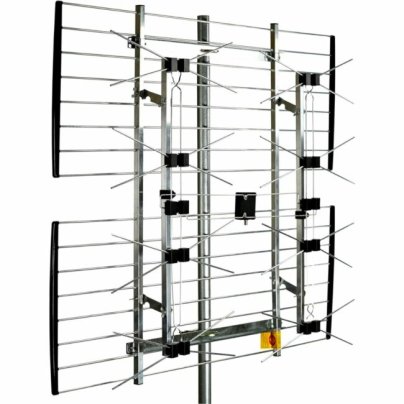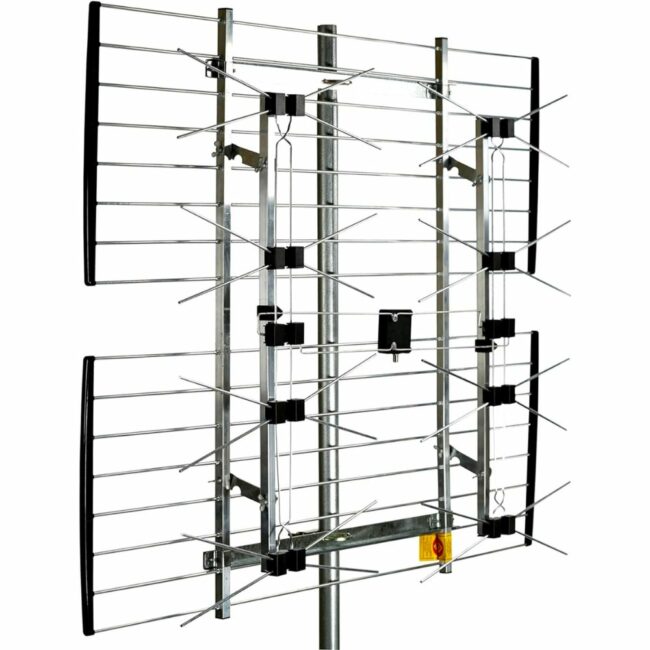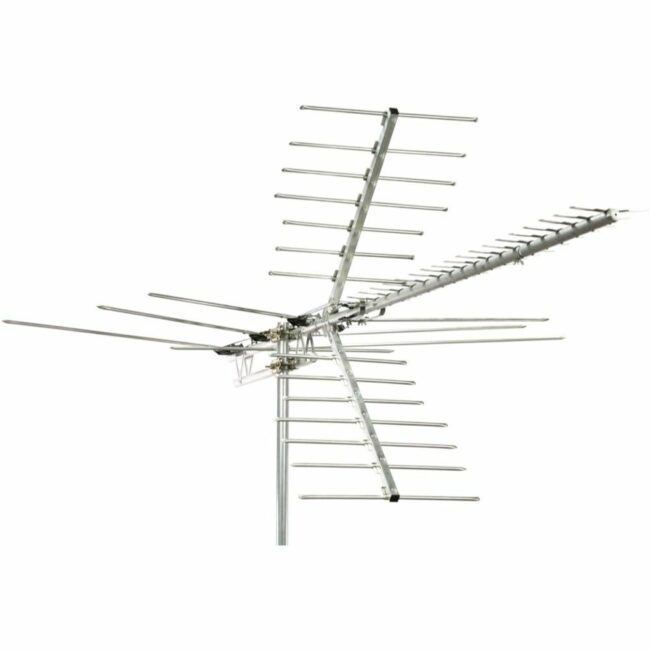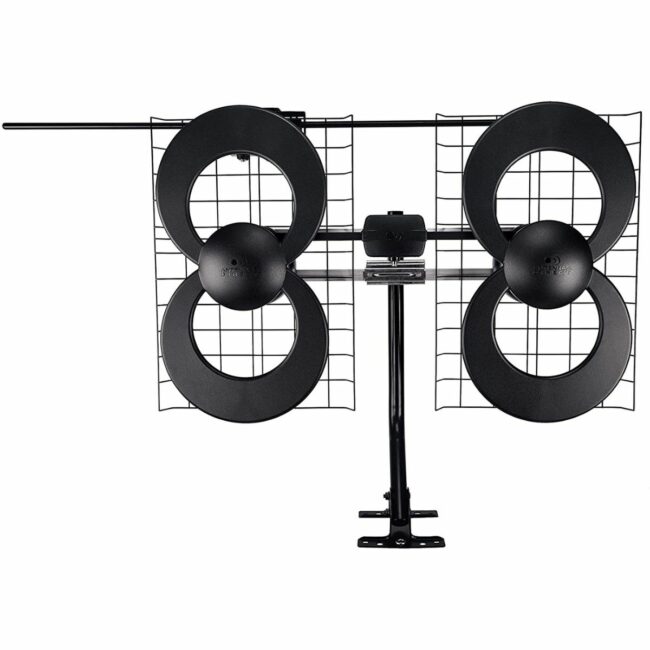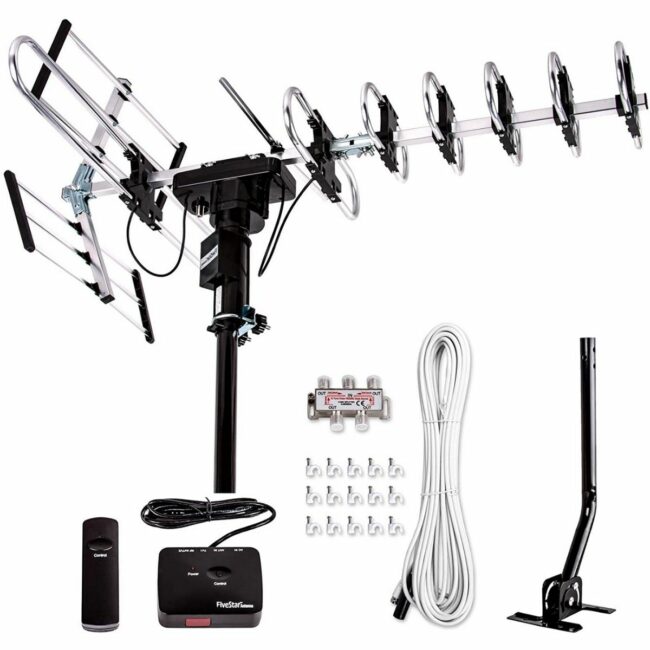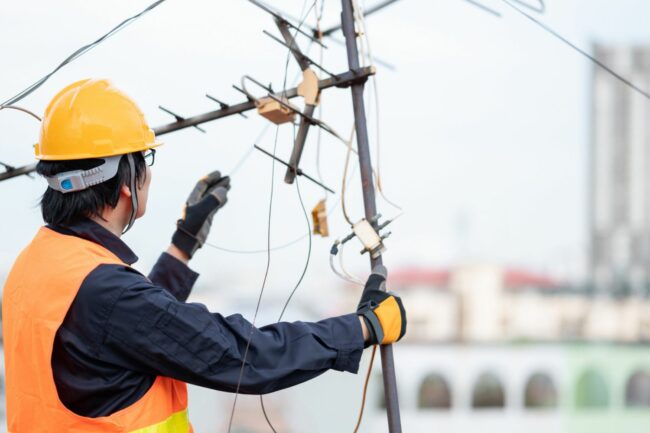
We may earn revenue from the products available on this page and participate in affiliate programs. Learn More ›
Instead of subscribing to streaming services, you could be pulling in free TV channels from the airwaves around your home. The best outdoor TV antennas require only a small investment of time and money, so in little time, you could be saving money on cable and subscription services while watching your favorite TV channels in HD quality.
Outdoor antennas can pull in a range of TV channels, including local, national, and public broadcasting. They’re also relatively easy to install, either by enlisting the help of a handyman or doing it yourself—provided you don’t have a fear of heights. This guide explores all of the factors and features to consider when shopping for an outdoor antenna, including a list of some of the best ones available.
- BEST OVERALL: Channel Master ExtremeTenna 80 Outdoor TV Antenna
- BEST BANG FOR THE BUCK: Pingbingding Digital Amplified Yagi HDTV Antenna
- UPGRADE PICK: Channel Master Digital Advantage 100 Antenna
- BEST COMPACT: Antennas Direct ClearStream 4V TV Antenna
- BEST LONG-RANGE: Five Star Long Range Digital Amplified HDTV Antenna
- BEST MOTORIZED: Pingbingding Digital Amplified Outdoor HD TV Antenna
- BEST FOR ATTIC INSTALLS: GE Outdoor HD Long-Range TV Antenna
- BEST APP SUPPORT: RCA Compact Outdoor/Attic HDTV Antenna
- BEST FOR RURAL AREAS: Antennas Direct 8-Element Bowtie Outdoor HDTV Antenna
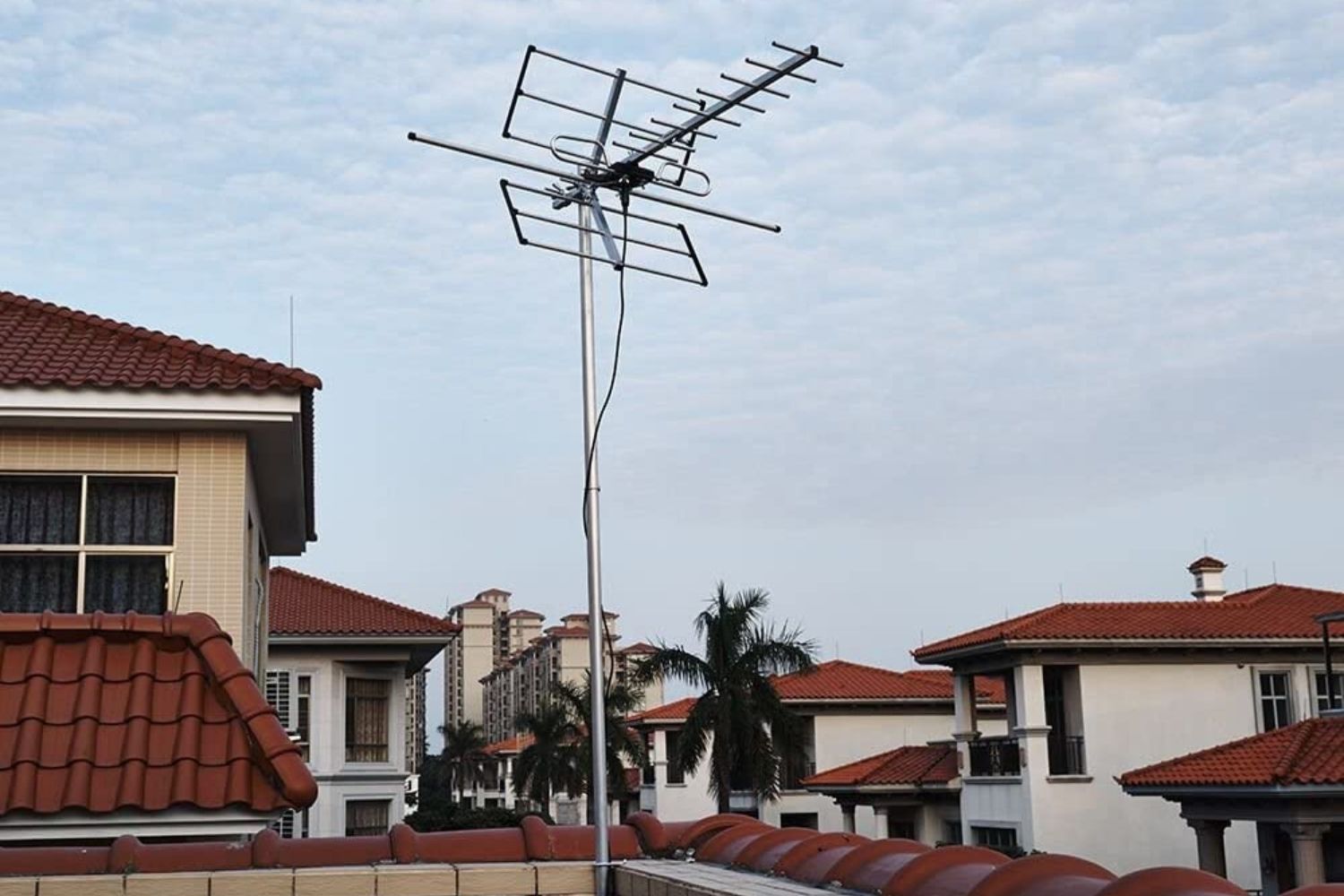
How We Chose the Best Outdoor TV Antennas
The best outdoor TV antenna should provide a clear picture and offer ample channel options. Our top choices were based on size, mile range, frequencies provided, durable construction, and special features.
The above picks prioritize medium- and large-size options for better connection when watching live TV or HDTV in the entertainment or living room. For those who live close to broadcasting towers and prefer local news, small options are also featured. Though our picks vary in size, they offer a range of 70 to 200 miles for maximum coverage. All of these offerings also provide VHF and UHF signals, increasing the number of channels available, as well as HDTV 1808i, FM, and 4K and 8K resolution.
Many selections are made from durable materials and mounting hardware to withstand all-season weather. For added convenience, some also include built-in amplifiers, smartphone connectivity, remote controls, and 180- to 360-degree fields of vision. A few of the best TV antennas can even be used as indoor antennas for attic spaces.
Our Top Picks
The best outdoor TV antennas are reliable and deliver solid reception. Some have incredibly long ranges, which are great at picking up TV signals for residents of remote areas. Others are compact and less obtrusive. Here are some of the best ones on the market.
Best Overall
Channel Master ExtremeTenna 80 Outdoor TV Antenna
Pros
- Capable of providing HD-quality picture; ideal for most TV watchers
- Covers a wide range with a 180-degree field of view
- Includes multiple signals such as FM, VHF, and UHF, covering multiple channels
Cons
- Some parts sold separately, making it more complicated to install
Product Specs
- Antenna size: Large (33 inches wide by 41 inches high)
- Range: 80 miles
- Ease of installation: Moderate
Channel Master has been around since the beginning of TV antenna technology. The ExtremeTenna 80is a product of all those years of research and innovation. This HD outdoor TV antenna from Channel Master has a 180-degree field of view and can pick up channels within 80 miles of a broadcast tower—including VHF, UHF, FM, and HD signals—so homeowners cutting the cord for the first time don’t have to sacrifice their favorite channels.
This Channel Master antenna requires additional parts for installation. The kit doesn’t include a pole (more appropriately referred to as the mast) or the brackets required to mount it on the side of a house.
Get the Channel Master outdoor TV antenna at Amazon or Channel Master.
Best Bang for the Buck
Pingbingding Digital Amplified Yagi HDTV Antenna
Pros
- Flexible use; works as a VHF, UHF, and HDTV antenna for watching multiple HD channels
- Built-in amplifier helps boost the signal; can help in dense or remote areas
- Includes brackets for mounting, making installation a little easier than other options
Cons
- Installation still may be difficult as it must be placed as high as possible
Product Specs
- Antenna size: Medium
- Range: 120 miles
- Ease of installation: Moderate
Anyone who wants to try over-the-air television without a large investment will want to check out the Pingbingding Amplified Yagi HDTV antenna. When calibrated toward a broadcast tower, this outdoor antenna has a 120-mile range, which is ideal for HD channels and for residents of remote locations. The antenna picks up VHF, UHF, and HD broadcasts, with a built-in amplifier that helps to provide the best possible audio and video quality. It ships mostly assembled and ready to install.
This outdoor HDTV antenna includes the brackets required to secure it to a pole, though the pole will need to be self-installed. It’s also worth noting that the higher this antenna is mounted, the more channels it receives. While this is true for all antennas, lower-end antennas, in particular, need to be installed as high as possible for the best reception.
Get the Pingbingding outdoor HDTV antenna at Amazon or Pingbingding.
Upgrade Pick
Channel Master Digital Advantage 100 Antenna
Pros
- UHF, VHF, and HD connections included; HDTV channels included
- Holds up in extreme weather conditions when mounted properly
- Installation hardware included for user-friendliness
Cons
- Amplifier, coax cable, and pole not included
Product Specs
- Antenna size: Large
- Range: 100 miles
- Ease of installation: Moderate
When a manufacturer provides a range claim for an antenna, sometimes it oversells the product’s capabilities. That’s not the case with the Channel Master Digital Advantage Antenna. This outdoor TV antenna picks up UHF, VHF, and HDTV channels, provided it’s lined up properly with a broadcast tower, within a 100-mile range. This Channel Master‘s large size (almost 8 feet long) and quality components ensure that this antenna provides a clear broadcast to a TV.
This Channel Master outdoor TV antenna does not include a pole, coaxial cable, or amplifier. These items will need to be bought separately to complete the installation process.
Get the Channel Master outdoor TV antenna at Amazon.
Best Compact
Antennas Direct ClearStream 4V TV Antenna
Pros
- Smaller size still able to provide both UHF and VHF connections
- Receives HD 1080i channels without needing an additional amplifier
- Mounting hardware included with clear installation instructions; good for novice installers
Cons
- Smaller size and more limited range may not be suitable in some remote locations
Product Specs
- Antenna size: Medium
- Range: 70+ miles
- Ease of installation: Easy
When it comes to providing the most capability in a small package, the Antennas Direct ClearStream 4V TV antenna delivers. This compact antenna measures less than 30 inches wide and about 20 inches tall, and the kit includes the mounting pole and brackets for easy installation outdoors. A great choice for rural areas, the ClearStream 4V has a 70-mile range and picks up both UHF and VHF frequencies. This antenna will also pick up HD 1080i channels where they are readily available, without an extra amplifier.
This model includes the parts needed to mount it to a house, but a coaxial cable must be purchased separately.
Get the Antennas Direct ClearStream outdoor TV antenna at Amazon or Walmart.
Best Long-Range
Five Star Long Range Digital Amplified HDTV Antenna
Pros
- Huge range; ideal for picking up multiple UHF, VHF, and HD frequencies
- 360-degree motor included; great for easily finding the best signal
- Mounting hardware and pole included, all at an affordable price point compared to other options
Cons
- Some users report difficulties with range and durability; may struggle in more rugged environments
Product Specs
- Antenna size: Large
- Range: 200 miles
- Ease of installation: Moderate
Five Star’s outdoor digital amplified HDTV antenna has the wiring and hardware to hook up to five TVs—a nice feature for larger homes. A J-pole is included, allowing the buyer to mount the antenna to the roof of their home. This outdoor TV antenna provides a 200-mile range when installed within a relatively clear line of sight to the broadcast tower and picks up UHF, VHF, and HD frequencies where available. It also has a built-in 360-degree motor to help find the best signal direction.
This kit is fairly comprehensive and includes quite a few parts and hardware. It requires a bit of assembly, so anyone looking for a kit that’s ready to go out of the box may want to consider another option.
Get the Five Star outdoor HDTV antenna at Amazon, Walmart, or Newegg.
Best Motorized
Pingbingding Digital Amplified Outdoor HD TV Antenna
Pros
- 360-degree motor included can maneuver itself to find stronger signals
- Comes with a remote controller; reduces need for manual adjustments
- Includes coaxial cable and J-pole, which makes this quite affordable compared to other options
Cons
- May have connectivity issues with the included remote when used over long distances
Product Specs
- Antenna size: Small
- Range: 150 miles
- Ease of installation: Easy
This digital outdoor TV antenna from Pingbingding features easy-to-assemble parts that snap onto the antenna body for a relatively quick setup. It also offers a 360-degree motor, making reception adjustments at the touch of a button possible, either on the control box or with the paired remote controller. The antenna provides a 150-mile range and includes both a J-pole for easy mounting and a coaxial cable.
One issue of concern is that the wireless remote controller for the motor could potentially use the same frequencies as your television remote. If that’s the case, you’ll have to find a way to block the controller’s remote sensor.
Get the Pingbingding digital outdoor TV antenna at Amazon, Newegg, or Pingbingding.
Best for Attic Installs
GE Outdoor HD Long-Range TV Antenna
Pros
- Interior installation minimizes eyesores on the roof; provides better curb appeal
- Most mounting hardware is included with this outdoor antenna, making installation relatively easy
- Suitable for older or heritage homes; can be installed inside the attic
Cons
- For certain install requirements, additional parts may need to be purchased
- Limited range is likely not suitable for those located in remote areas
Product Specs
- Antenna size: Medium
- Range: 70 miles
- Ease of installation: Easy
This antenna from GE is powerful enough to install in an attic, keeping it out of sight. It’s a great option for heritage homes that have historical societies overseeing any modifications. The antenna offers a 70-mile range and includes the necessary parts to install in an attic or on a roof. It picks up HD broadcasts, working with both UHF and VHF frequencies.
While the kit includes the parts required to install this antenna in an attic, the buyer will need to purchase extra gear to hook up to several TVs, including an amplifier-splitter combination and coaxial cables.
Get the GE outdoor TV antenna at Amazon or Walmart.
Best App Support
RCA Compact Outdoor/Attic HDTV Antenna
Pros
- Adjustable through smartphone connection; much more convenient than manual adjustments
- Smaller size is easier to manage and safe to install in some attics
- Affordable price point compared to similar models offering the same features
Cons
- Some installation hardware not included; may require more for certain configurations
Product Specs
- Antenna size: Small
- Range: 75 miles
- Ease of installation: Moderate
One of the most challenging aspects of cord-cutting is the proper alignment of an outdoor TV antenna. RCA’s outdoor antenna uses a free smartphone app, the RCA Signal Finder, to help locate the best signal within a 70-mile radius. The kit includes the mounting brackets, power transformer, and snap-lock elements for easy installation. This antenna also has a relatively small footprint, so attic installations are not out of the question.
This model works as a 4K, 8K, and 1080 HDTV antenna, providing high-quality picture and sound with both UHF and VHF reception. While this RCA antenna includes almost everything one would need to get started, it doesn’t come with a coaxial cable; it will have to be purchased separately to connect it to a TV set.
Get the RCA outdoor HDTV antenna at Amazon, Newegg, or RCA.
Best for Rural Areas
Antennas Direct 8-Element Bowtie Outdoor HDTV Antenna
Pros
- Adjustable to either boost signal from 1 direction or pick up from multiple towers
- Able to protect against multipath interference; ideal for remote areas with foliage
- Users report excellent customer service when dealing with product issues
Cons
- Additional features to combat rural areas makes this a little pricier compared to other options
- Mount and coaxial cable required for installation is not included; needs additional purchases
Product Specs
- Antenna size: Large
- Range: 70+ miles
- Ease of installation: Moderate
This antenna array from Antennas Direct boasts a unique feature. The panels can be turned in different directions to pick up signals from broadcast towers across a wide space. Heavy foliage or roofing materials in rural areas can greatly decrease signal strength. Thankfully, the reflector technology in this antenna provides protection against multipath interference.
Its 70-mile range and adjustable configuration make it an ideal choice for users living outside of the city. While this antenna is not small, it may be the optimal choice for shoppers looking to maximize their TV viewing capabilities in remote locations. Note that this model may need additional hardware to mount and connect.
Get the Antennas Direct multidirectional outdoor TV antenna at Amazon, Lowe’s, Walmart, or Antennas Direct.
Jump to Our Top Picks
What to Consider When Choosing an Outdoor TV Antenna
Several factors need to be taken into consideration before buying an outdoor TV antenna. Where the house is located relative to area broadcast towers, for example, is an important one—the farther those towers are, the harder it’ll be for an antenna to pick up the broadcast signal. Here’s a closer look at what shoppers need to consider ahead of buying an outdoor TV antenna.
Location and Building Structure
A home’s location and construction can have a lot to do with choosing the right outdoor TV antenna. Someone who lives in a city, for example, will have different factors to contend with than someone living in a suburb or rural area.
With broadcast towers nearby, a city dweller might not have to worry much about their antenna’s reception. HOA restrictions or historical society rules on outdoor antennas may pose a problem, though. Many of these organizations don’t want outdoor TV antennas to be visible, so choosing a model that can be installed inside an attic might be a good choice.
Reception quality is a bigger concern for those who live in suburban, rural, or remote areas, far from broadcast towers. An outdoor TV antenna has to be affixed to a tall pole that lifts it as high above the house as possible to pick up a signal.
Antenna Size and Height
When shoppers are on the hunt for the best outdoor TV antenna, size and height can be important factors in how well the device will work. The signal waves that antennas pick up can be blocked by large obstructions like tall buildings, mountains, and even large depressions in the ground. If a homeowner gets poor reception, it might be due to a blockage between the house and the broadcast tower.
In this case, they can purchase a larger antenna or increase the height of the existing one. A taller antenna is more likely to pick up a quality signal and improve reception. This is especially true in a valley. However, larger antennas can pick up weaker TV signals, so they also have their benefits.
Signal Range
If a standard cable isn’t available in the immediate area, the signal range is, by far, the most important factor when choosing the best outdoor TV antenna. For those located a short distance from a broadcast tower, an antenna with a 70-mile range is more than sufficient. Those who are nowhere near the closest broadcast tower will likely find a short-range antenna useless. Instead, they should look for an antenna with a 150- to 200-mile range for optimal broadcast TV quality.
While a signal amplifier can be purchased, too, they usually don’t improve the antenna’s reception. They simply make up for the quality and signal loss that occurs between the antenna and the TV. That said, signal loss could be the actual problem—not the reception the antenna is receiving. In that case, a signal amplifier may be a potential solution.
HD Capability
Whether HD capability actually matters much to the quality of TV programming is a controversial point. Most outdoor TV antenna manufacturers claim their products offer HD capability. For this reason, it might be worth considering if only as an indication of capability.
In today’s TV broadcasting, antennas receive a digital signal, which means the device picks up a channel or it doesn’t. Someone experiencing poor reception likely won’t see a fuzzy picture. Instead, the TV screen will display a “no signal” message. So, if an outdoor HD antenna truly has HD capability, the TV screen should—in most cases—display crystal clear signal quality.
Omnidirectional Reception
Those who aren’t interested in dialing in the perfect reception but would rather purchase a set-and-forget type should consider an omnidirectional antenna. These antennas don’t need to be pointed directly at a broadcast tower for the best possible reception. Instead, these round, disc-like outdoor TV antennas can draw reception from any direction.
These antennas do have their limitations, though. Many omnidirectional antennas, for example, have shorter ranges than the directional types. This type of outdoor TV antenna might be a better option for someone who lives relatively close (less than 100 miles) to a broadcast tower, making it easier to receive a solid signal.
Connectivity
While it’s possible to connect more than one TV to an outdoor TV antenna, there are several factors to consider. It usually works well to use a splitter to divert an antenna’s signal to connect to two TVs; however, it can be difficult to divert the signal to more than two TVs if the antenna doesn’t support dual connectivity. If a coaxial splitter wasn’t included with the outdoor TV antenna purchase, it will have to be bought separately to take advantage of dual connectivity. Despite the word “dual,” it is typically possible to split the signal among three or more separate TVs using a coaxial splitter.
Cabling
If someone lives within range of broadcast towers and has their outdoor TV antenna pointed directly at them yet still gets bad reception, a cabling problem might be the cause.
A broadcast signal travels from the source to the TV through a coaxial cable. Not all coaxial cables are high quality, though. A coaxial cable is available in various grades, with RG-6 being sufficient for standard TV reception and RG-11 being the best for an HD signal. An HD-ready coaxial cable typically provides the best pathway for an antenna’s signal to travel to the TV.
It’s worth noting that a signal amplifier can be added but it won’t necessarily increase the antenna’s reception. It will only work to improve the quality of the signal from the antenna.
Ease of Installation
There’s a reason antenna installers are paid well: It’s not always easy work. Anyone who considers themselves particularly handy can likely install and set up an outdoor TV antenna, though. Most kits provide the necessary hardware to bolt the antenna to a pole, though few include the pole itself.
Choosing an antenna that can be self-installed can save quite a bit of money, even if the pole must be purchased separately. The antenna brackets should be installed on the house or roof first followed by the antenna and pole as a unit. Trying to secure the antenna to the end of a long pole while standing on a roof or ladder several feet above ground should never be attempted for safety reasons.
Tips for Using an Outdoor TV Antenna
Reception and broadcast quality tend to be the top issues outdoor TV antenna users face. If reception is the issue, installing the antenna to a taller pole or mast that lifts it higher above the house might help—the taller the antenna, the better the reception. The entire unit should be brought to the ground in one piece to swap the antenna onto the taller pole and then reinstall it as one piece.
If the TV has a signal gauge, this gauge can be used to determine the location of the best quality signal in the area. While repositioning the antenna, the TV’s signal gauge will adjust accordingly when the antenna’s pointed in the direction of the strongest signal.
Transmitter maps can also help determine the location of the closest broadcast towers in an area. The closest tower may not be the best one, however, if it’s blocked by mountains or other obstructions.
FAQs
Shoppers often wonder whether the outdoor TV antenna they’re considering will work properly once it’s installed. Some don’t know how to find the right spot to install it, while others worry about connection issues. Here are answers to some of the most commonly asked questions shoppers have about outdoor TV antennas.
Q. How does an outdoor TV antenna work?
An outdoor TV antenna intercepts VHF and UHF signals that broadcast towers transmit and sends them to the connected TV. Those TV signals become onscreen images and audio.
Q. Can I put an indoor TV antenna outside?
Indoor antennas may work outside, but they’re rarely water- and weather-resistant enough to sustain outdoor conditions. An outdoor model is built to weather the elements.
Q. How do I get the best outdoor antenna reception?
Point the antenna toward the strongest broadcast tower in the area. Also, consider raising the antenna higher so it can capture the strongest signals. Nearby thick foliage or roofing material can often weaken the signal.
Q. Does aluminum foil boost antenna signal?
Aluminum foil does increase an antenna’s conductive surface area, boosting its signal. It’s unlikely that wrapping an antenna with aluminum foil will work past the first strong windstorm, though.
Q. Can I install an outdoor TV antenna myself?
An outdoor TV antenna can be self-installed as long as the person installing it is comfortable with heights. In most cases, climbing a tall ladder is necessary. Aside from this, mounting and installation itself is usually quite straightforward.
